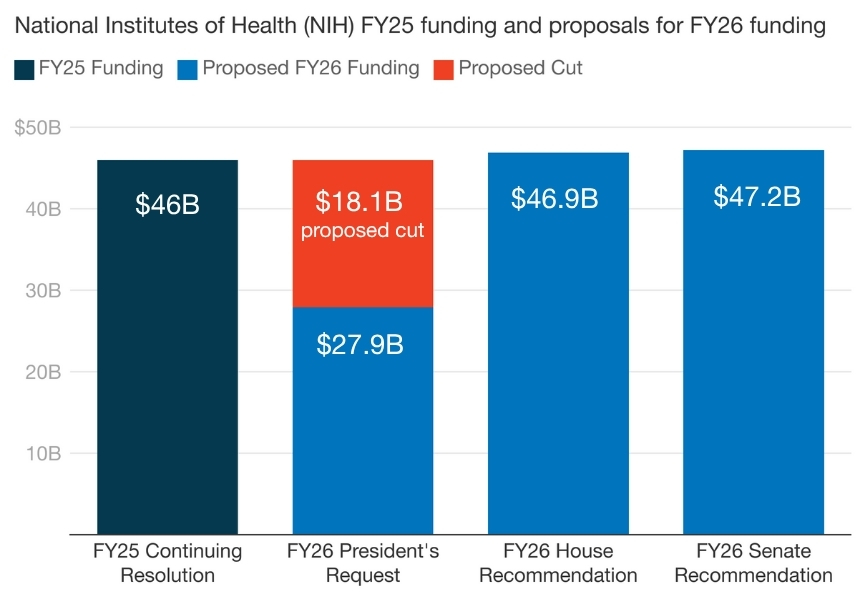The Association of American Universities (AAU) urges Congress to sustain funding for the National Institutes of Health (NIH) at FY25 levels. The administration’s proposal to cut the NIH by 40%, if enacted, would devastate the agency’s ability to advance knowledge to enhance human health, cure infectious and chronic disease, lengthen life, and reduce mortality and terminal illness. To maintain its position as the premier biomedical research agency in the world, NIH requires sustained and predictable investment. We applaud both the House and Senate Committees on Appropriations for their bipartisan support for the NIH and for their recommendations to fund the agency at $46.9 billion and $47.2 billion, respectively.

NIH invests in medical research for the American people
- NIH-funded foundational and clinical research is behind nearly every advancement in treating chronic and infectious diseases that are the leading causes of death in the United States: heart disease, cancer, stroke, Alzheimer’s disease, diabetes, and opioid use disorder.
- The partnership between the NIH and America’s research universities is essential to developing new diagnostics, treatments, and cures that improve health outcomes for the American people, protect our national interests, and enhance our global competitiveness.
- More than half of FDA-approved drugs since 2000 are connected to NIH research that would likely have been cut under a 40% reduction, according to recent research.
- More than 80% of NIH’s budget supports cutting-edge research through a competitive, merit-based process that annually awards grants to more than 300,000 researchers at more than 2,500 universities, medical schools, and institutions in all 50 states.
NIH transforms discoveries into diagnostics, treatments, and cures
- Cancer: NIH's long-term investments in cancer research reduced overall death rate by 33% over 30 years. NIH-funded foundational research discovered the genetic mutations responsible for specific cancers. Advances in understanding the immune system have led to the development of immunotherapies for cancer and precision cancer treatments, extending the lives of cancer patients.
- Heart disease: Deaths from heart disease fell nearly 68% because of research advanced from the NIH-funded Framingham Heart Study, a long-term NIH-funded cohort study that identified risk factors such as obesity, smoking, high blood pressure, and high cholesterol, and spurred the development of statins, beta blockers, and other heart medications.
- Diabetes: NIH-funded research has led to the development of rapid-acting insulin and blood glucose monitoring to treat and manage Type 1 diabetes and to the development of GLP-1 agonists to manage glucose and treat Type 2 diabetes.
- Opioid use disorder: NIH-funded research led to the development of buprenorphine, medication treatment for opioid use disorder, and to naloxone nasal spray, a lifesaving tool that can reverse the effects of overdose.
- Alzheimer’s disease: NIH-supported research led to the identification of biomarkers for beta-amyloid plaques, a hallmark of Alzheimer’s disease, which then led to treatments for symptoms.
NIH catalyzes new scientific methods, tools, and resources
- Clinical Trials: National Cancer Institute’s Clinical Trials Network, which is composed of 2,500 sites, enables researchers and clinicians to test novel therapies and techniques to prevent, diagnose, and treat cancer, the leading cause of death after heart disease. NIH conducts more than 4,300 clinical trials for cancer therapies and treatments for other diseases, giving hope to patients and extending life for individuals for whom no other cure or treatment currently exists.
- Human genome sequencing and gene editing: The Human Genome Project sequenced the human genome for the first time, which gave rise to gene therapy research and CRISPR-Cas9 technology. CRISPR is the most commonly used gene editing tool used to diagnose and treat genetic diseases.
- Mapping the brain: The Human Connectome Project mapped long-distance brain connections in 1,200 healthy young adults, deepening our understanding of how genetics and the environment contribute to differences in brain function – critical to developing new approaches to treating dementia, epilepsy, and Alzheimer’s disease.
NIH trains the scientific and biomedical workforce
The NIH invests in people – established physicians and scientists as well as those in training at the undergraduate, graduate, and postgraduate levels who make progress in treating and ending chronic and infectious disease possible. These investments cultivate the next generation of scientific talent and maintain American leadership in biomedical innovation.
NIH is an economic engine driving national and regional growth
- In FY24, the NIH awarded nearly $37 billion in grants to researchers in all 50 states and the District of Columbia. These grants supported nearly $95 million in new economic activity and nearly 408,000 jobs.
- For every $1 the NIH invests in research, communities see a $2.56 economic return.